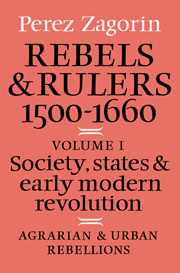2 - Conspectus, typology, causality
Published online by Cambridge University Press: 12 January 2010
Summary
The revolutions selected for consideration in this book almost all occurred in the century and a half between the beginning of the sixteenth and the middle of the seventeenth century. Moreover, with the main exception of the German peasant war, they belong almost entirely to the history of three states: England, France, and the Spanish empire. The rationale for this choice of locale in space and time as the basis for a study of early modern revolutions is explained by a number of reasons.
Far across the abyss of time, before the French revolution and the emergence of industrial society, lies spread out and stretching backward into the past the Western Europe of the old society. Dominated in its polities by monarchies and princes and in its social structures by nobilities and aristocracies, still rural despite its great capital cities, still agricultural despite its commerce, manufactures, and bourgeoisie, this is the society that grew out of the feudal world and was eventually to be transformed during the nineteenth century into the industrial world. One phase of its life history, the last, which was disrupted by the French revolution, is usually known as the ancien régime. The whole of its history is commonly described as the early modern era, extending from about 1500 to the late eighteenth century and the outbreak of the French revolution.
Of this period it was the first half, broadly speaking, that witnessed the basic advances in the building of states, the introduction or growth of institutions designed to consolidate centralized government, and the decay of older institutions that stood in the way.
- Type
- Chapter
- Information
- Rebels and Rulers, 1500–1600Society, States, and Early Modern Revolution, pp. 28 - 58Publisher: Cambridge University PressPrint publication year: 1982

